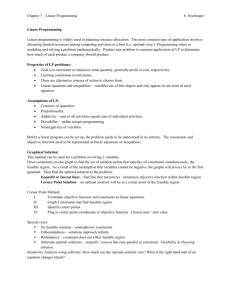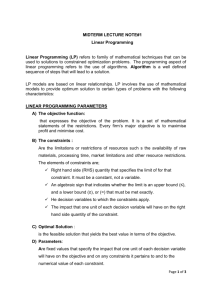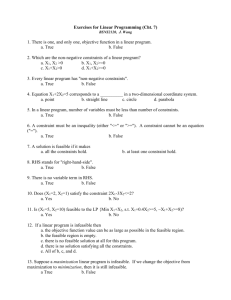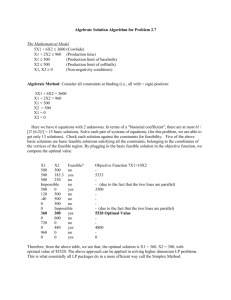Model Formulation and Graphical Method
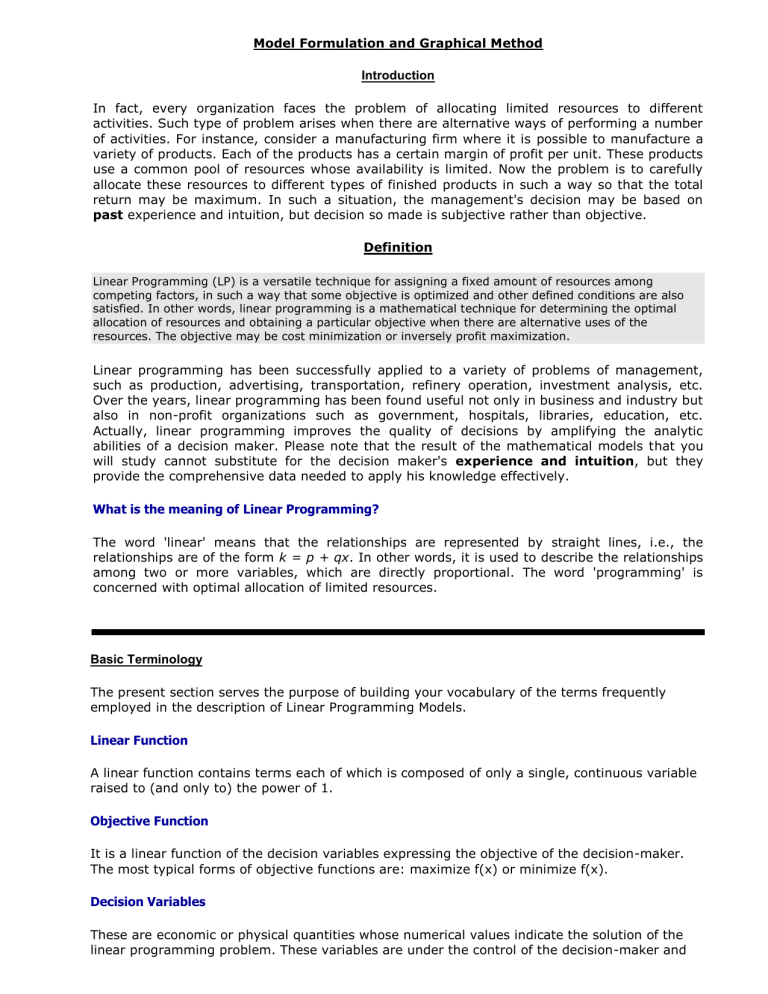
Model Formulation and Graphical Method
Introduction
In fact, every organization faces the problem of allocating limited resources to different activities. Such type of problem arises when there are alternative ways of performing a number of activities. For instance, consider a manufacturing firm where it is possible to manufacture a variety of products. Each of the products has a certain margin of profit per unit. These products use a common pool of resources whose availability is limited. Now the problem is to carefully allocate these resources to different types of finished products in such a way so that the total return may be maximum. In such a situation, the management's decision may be based on
past experience and intuition, but decision so made is subjective rather than objective.
Definition
Linear Programming (LP) is a versatile technique for assigning a fixed amount of resources among competing factors, in such a way that some objective is optimized and other defined conditions are also satisfied. In other words, linear programming is a mathematical technique for determining the optimal allocation of resources and obtaining a particular objective when there are alternative uses of the resources. The objective may be cost minimization or inversely profit maximization.
Linear programming has been successfully applied to a variety of problems of management, such as production, advertising, transportation, refinery operation, investment analysis, etc.
Over the years, linear programming has been found useful not only in business and industry but also in non-profit organizations such as government, hospitals, libraries, education, etc.
Actually, linear programming improves the quality of decisions by amplifying the analytic abilities of a decision maker. Please note that the result of the mathematical models that you will study cannot substitute for the decision maker's experience and intuition, but they provide the comprehensive data needed to apply his knowledge effectively.
What is the meaning of Linear Programming?
The word 'linear' means that the relationships are represented by straight lines, i.e., the relationships are of the form k = p + qx. In other words, it is used to describe the relationships among two or more variables, which are directly proportional. The word 'programming' is concerned with optimal allocation of limited resources.
Basic Terminology
The present section serves the purpose of building your vocabulary of the terms frequently employed in the description of Linear Programming Models.
Linear Function
A linear function contains terms each of which is composed of only a single, continuous variable raised to (and only to) the power of 1.
Objective Function
It is a linear function of the decision variables expressing the objective of the decision-maker.
The most typical forms of objective functions are: maximize f(x) or minimize f(x).
Decision Variables
These are economic or physical quantities whose numerical values indicate the solution of the linear programming problem. These variables are under the control of the decision-maker and
could have an impact on the solution to the problem under consideration. The relationships among these variables should be linear.
Constraints
These are linear equations arising out of practical limitations. The mathematical forms of the constraints are: f(x) b or f(x) b or f(x) = b
Feasible Solution
Any non-negative solution which satisfies all the constraints is known as a feasible solution. The region comprising all feasible solutions is referred to as feasible region.
Optimal Solution
The solution where the objective function is maximized or minimized is known as optimal solution.
Graphical Method - Introduction
Linear programming problems with two decision variables can be easily solved by graphical method. A problem of three dimensions can also be solved by this method, but their graphical solution becomes complicated.
Basic Terminology
Feasible Region
It is the collection of all feasible solutions. In the following figure, the shaded area represents the feasible region.
Convex Set
A region or a set R is convex, if for any two points on the set R, the segment connecting those points lies entirely in R. In other words, it is a collection of points such that for any two points on the set, the line joining the points belongs to the set. In the following figure, the line joining P and Q belongs entirely in R.
Thus, the collection of feasible solutions in a linear programming problem form a convex set.
Redundant Constraint
It is a constraint that does not affect the feasible region.
Example: Consider the linear programming problem:
Maximize 1170 x
1
+ 1110x
2 subject to
9x
1
+ 5x
2
500
7x
1
+ 9x
2
5x
1
7x
1
+ 3x
2
+ 9x
2
300
1500
1900
2x
1
+ 4x
2
1000 x
1
, x
2
0
The feasible region is indicated in the following figure:
The critical region has been formed by the two constraints.
9x
1
+ 5x
2
500
7x
1
+ 9x
2
1900 x
1
, x
2
0
The remaining three constraints are not affecting the feasible region in any manner. Such constraints are called redundant constraints.
Extreme Point
Extreme points are referred to as vertices or corner points. In the following figure, P, Q, R and S are extreme points.
Graphical Method - Algorithm
The details of the algorithm for this method are as follows.
Steps
1.
Formulate the mathematical model of the given linear programming problem.
2.
Treat inequalities as equalities and then draw the lines corresponding to each equation and non-negativity restrictions.
3.
Locate the end points (corner points) on the feasible region.
4.
Determine the value of the objective function corresponding to the end points determined in step 3.
5.
Find out the optimal value of the objective function.
The examples to follow illustrate the method.
Graphical Method - Examples
Example 1
Maximize z = 18x
1
+ 16x
2 subject to
24x
1
15x
1
+ 25x
2
375
+ 11x
2
264 x
1
, x
2
0
Solution.
If only x
1
and no x
2
is produced, the maximum value of x produced, the maximum value of x
+ 25x
2
1
is 375/15 = 25. If only x
2
and no x
2
is 375/25 = 15. A line drawn between these two points (25,
0) & (0, 15), represents the constraint factor 15x
1
375. Any point which lies on or
1
is below this line will satisfy this inequality and the solution will be somewhere in the region bounded by it.
Similarly, the line for the second constraint 24x
1
+ 11x
2
264 can be drawn. The polygon oabc represents the region of values for x
1
& x
2
that satisfy all the constraints. This polygon is called the solution set.
The solution to this simple problem is exhibited graphically below.
The end points (corner points) of the shaded area are (0,0), (11,0), (5.7, 11.58) and (0,15).
The values of the objective function at these points are 0, 198, 288 (approx.) and 240. Out of these four values, 288 is maximum.
The optimal solution is at the extreme point b, where x
1
= 5.7 & x
2
= 11.58, and z = 288.
Example 2
Maximize z = 6x
1
- 2x
2 subject to
2x
1 x
1
- x
3
2
2
x
1
, x
2
0
Solution.
First, we draw the line 2x
1 the region bounded by it.
- x
2
2, which passes through the points (1, 0) & (0, -2). Any point which lies on or below this line will satisfy this inequality and the solution will be somewhere in
Similarly, the line for the second constraint x
1
3 is drawn. Thus, the optimal solution lies at one of the corner points of the dark shaded portion bounded by these straight lines.
Optimal solution is x
1
= 3, x
2
= 4.2, and the maximum value of z is 9.6.
Special Cases
Multiple Optimal
Solutions
Infeasible Solution
Unbounded Solution
1. Multiple Optimal Solutions
The linear programming problems discussed in the previous section possessed unique solutions.
This was because the optimal value occurred at one of the extreme points (corner points). But situations may arise, when the optimal solution obtained is not unique. This case may arise when the line representing the objective function is parallel to one of the lines bounding the feasible region. The presence of multiple solutions is illustrated through the following example.
Maximize z = x
1
+ 2x
2 subject to x
1
80 x
2
5x x
1
60
1
+ 6x
+ 2x
2
2
600
160 x
1
, x
2
0.
In the above figure, there is no unique outer most corner cut by the objective function line. All points from P to Q lying on line PQ represent optimal solutions and all these will give the same optimal value (maximum profit) of Rs. 160. This is indicated by the fact that both the points P with co-ordinates (40, 60) and Q with co-ordinates (60, 50) are on the line x multiple solutions.
1
+ 2x
2
= 160. Thus, every point on the line PQ maximizes the value of the objective function and the problem has
2. Infeasible Problem
In some cases, there is no feasible solution area, i.e., there are no points that satisfy all constraints of the problem. An infeasible LP problem with two decision variables can be identified
through its graph. For example, let us consider the following linear programming problem.
Minimize z = 200x
1
+ 300x
2 subject to
2x
1
+ 3x
2
1200 x
1
+ x
2
400
2x
1
+ 1.5x
2
900 x
1
, x
2
0
The region located on the right of PQR includes all solutions, which satisfy the first and the third constraints. The region located on the left of ST includes all solutions, which satisfy the second constraint. Thus, the problem is infeasible because there is no set of points that satisfy all the three constraints.
3. Unbounded Solutions
It is a solution whose objective function is infinite. If the feasible region is unbounded then one or more decision variables will increase indefinitely without violating feasibility, and the value of the objective function can be made arbitrarily large. Consider the following model:
Minimize z = 40x
1
+ 60x
2 subject to
2x
1
+ x
2 x
1 x
1
+ x
2
+ 3x
40
2
90
70 x
1
, x
2
0
The point (x
1 portion.
, x
2
) must be somewhere in the solution space as shown in the figure by shaded
The three extreme points (corner points) in the finite plane are:
P = (90, 0); Q = (24, 22) and R = (0, 70)
The values of the objective function at these extreme points are:
Z(P) = 3600, Z(Q) = 2280 and Z(R) = 4200
In this case, no maximum of the objective function exists because the region has no boundary for increasing values of x
1
and x
2
. Thus, it is not possible to maximize the objective function in this case and the solution is unbounded.
Limitations of Linear Programming
Linearity of relations: A primary requirement of linear programming is that the objective function and every constraint must be linear. However, in real life situations, several business and industrial problems are nonlinear in nature.
Single objective: Linear programming takes into account a single objective only, i.e., profit maximization or cost minimization. However, in today's dynamic business environment, there is no single universal objective for all organizations.
Certainty: Linear Programming assumes that the values of co-efficient of decision variables are known with certainty.
Due to this restrictive assumption, linear programming cannot be applied to a wide variety of problems where values of the coefficients are probabilistic.
Constant parameters: Parameters appearing in LP are assumed to be constant, but in practical situations it is not so.
Divisibility: In linear programming, the decision variables are allowed to take nonnegative integer as well as fractional values. However, we quite often face situations where the planning models contain integer valued variables. For instance, trucks in a fleet, generators in a powerhouse, pieces of equipment, investment alternatives and there are a myriad of other examples. Rounding off the solution to the nearest integer will not yield an optimal solution. In such cases, linear programming techniques cannot be used.



